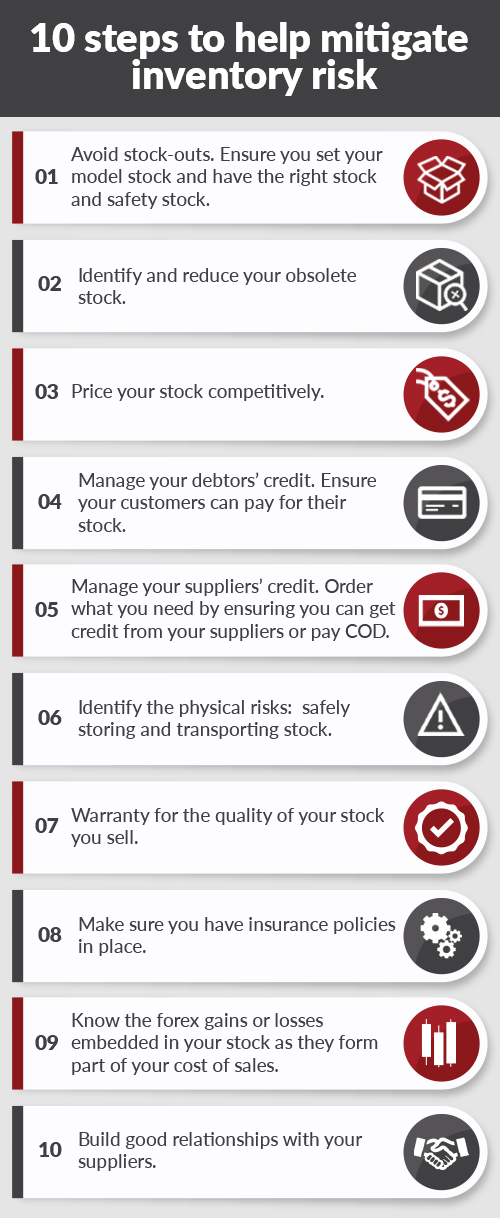Disruptions in your supply chain operations will put your business at risk, creating costly setbacks if you don’t mitigate as much of the risk as possible.
Even if you have the right quantity of inventory and there are no delays in either manufacturing or supplying the stock, there are still risks associated with your inventory. Identifying those risks will help you to create an effective risk management strategy to manage and allocate your investment optimally.
We explore how inventory risk affects your business. Two leading industry experts, Netstock’s Group CEO Tony Sinton and former CEO Miles Crisp, from Tarsus Distribution, a leading technology and electronics distributor in Southern Africa, share their experiences of managing inventory.
Your inventory goal: To achieve a balanced inventory investment through effective inventory optimization.
When helping businesses manage their inventory, we extract what is needed to improve our customers’ inventory performance. We help our customers identify the right investment in inventory, that is appropriate to meet the needs of the business, and that is going to meet their strategic objectives- including the allocation of working capital to inventory and their target fill rates – Tony Sinton, Netstock Group CEO.
An inventory management perspective: How can you effectively improve the performance of your inventory?
Step one: Understand your inventory risk drivers
There are two elements of inventory risk: your supply and your demand.
The supply risk deals with understanding how the supplier performs, whether they are regular suppliers and if they supply on time and in full. This allows you to build up an inventory risk profile for every item that exists in your business. That means every item at every location potentially has its supplier performance metrics, and you understand those metrics at the individual SKU level.
On the other side, demand risk is understanding projected demand and forecast regarding what stock items are expected to sell. The risk is having the demand exceed the total supply, so you will experience stock-outs which affects your ability to meet the demand.
Understanding these risks and interpreting them at the line item level is essential to managing inventory effectively.
Step two: Set your model stock
Can you answer this question: How much inventory should you have? If you are a CFO, the typical answer is ‘it should be less!’ or if you are a salesperson, ‘it should be more!’.
Model stock is like your ‘north star’ where you ensure you have the right amount of stock available to sell. Your model stock is designed to show you where you are heading in terms of stockholding.
To establish your model stock, you need to develop a risk profile for each line item by analyzing the items’ specific supplier performance and forecast history. Once every line item has a risk profile, you can calculate your desired inventory model.
Once you have determined your ideal model stock, you need to be confident that every replenishment decision will drive your inventory towards that objective.
Step three: Know where your business sits on the inventory maturity curve
Understanding where your business sits on the inventory maturity curve will guide you when deciding when to invest in new processes or technologies. If your business is not ready for such an investment, you can potentially disrupt your operations, processes, and people.
Connect with Tony to discuss the inventory maturity curve concerning your business.
A business perspective: How can you optimize your investment in inventory?
Inventory is way more complex than what people think. In my experience, when I joined Tarsus, an organization that moves thousands of SKUs worth hundreds of thousands of Rands worth of goods every single month, you quickly realize, if you get that [ordering stock] wrong, it can sink the entire business. Inventory is a balancing act between the amount of stock you can hold, especially when you have line items aging or superseded by new technology; you run the risk of holding stock that nobody wants. – Miles Crisp, former CEO of Tarsus Distribution.
A blended approach of utilizing technology and human intelligence to help optimize your inventory.
Having the right technology in place that provides intelligent data complemented by your in-house expertise is a step in the right direction.
Intelligent data is not enough on its own and needs to be aligned with one’s insights into market trends and human intuition, just as the human element without data is not practical.
When deciding to implement new technology to help optimize your inventory you need ‘buy in’ from your finance, sales, marketing, and demand planning teams so that your team can:
- fully understand why the technology has been selected and the benefits of the technology and
- know how to use the technology so they can experience how the technology can benefit their job function.
A crucial part of implementing new technology or processes is training your team on using the technology effectively.
……with the help of the Netstock team, once we implemented Netstock, additional training sessions were conducted live using our data. The Netstock customer support team, and in many instances Tony personally, would dive into a particular problem about a particular SKU or category of stock with the Tarsus product manager and look at particular problems, teaching us using live data. – Miles Crisp, former CEO of Tarsus Distribution.
To act quickly and mitigate risks, you need full visibility of your inventory holding.
To be proactive, using a dashboard will give you full visibility of your key indicators and show your stockholding, where and why you are overstocked, and where you cannot meet customer demands.
If you are curious to know how effectively your inventory is performing, take our quick inventory performance quiz below.
{{cta(‘c9eb1283-180e-4eab-b880-3adc30ea9b1b’,’justifycenter’)}}





